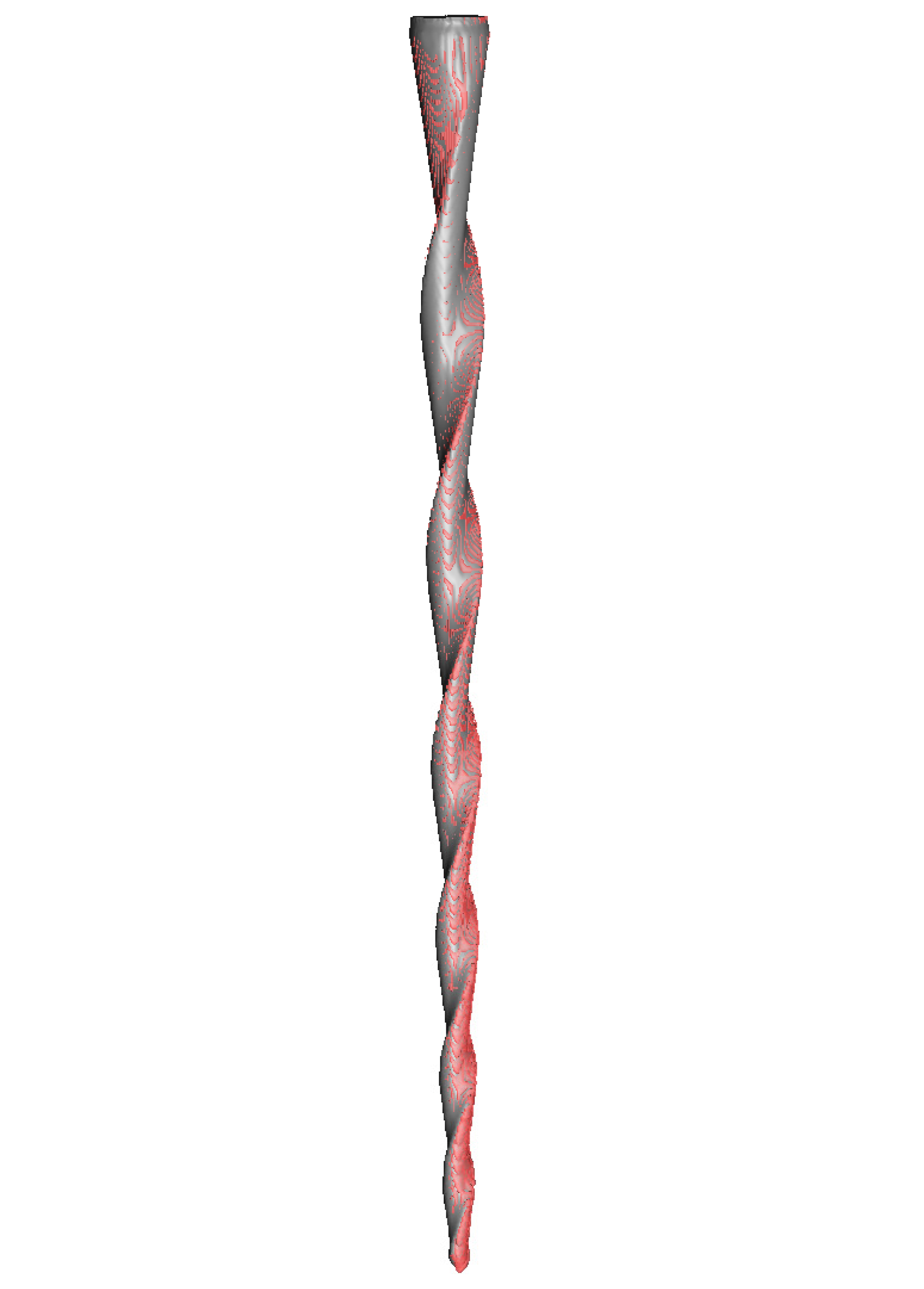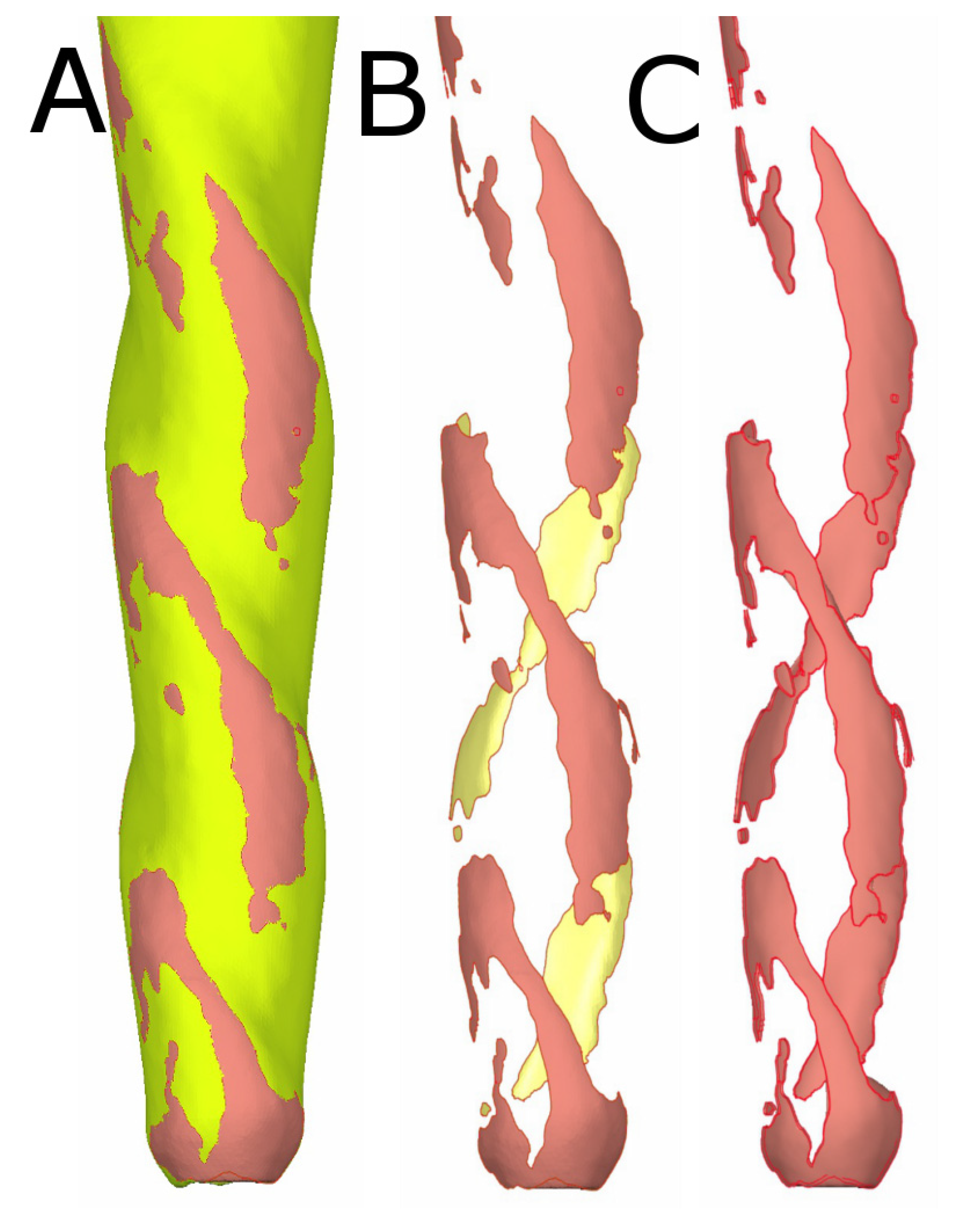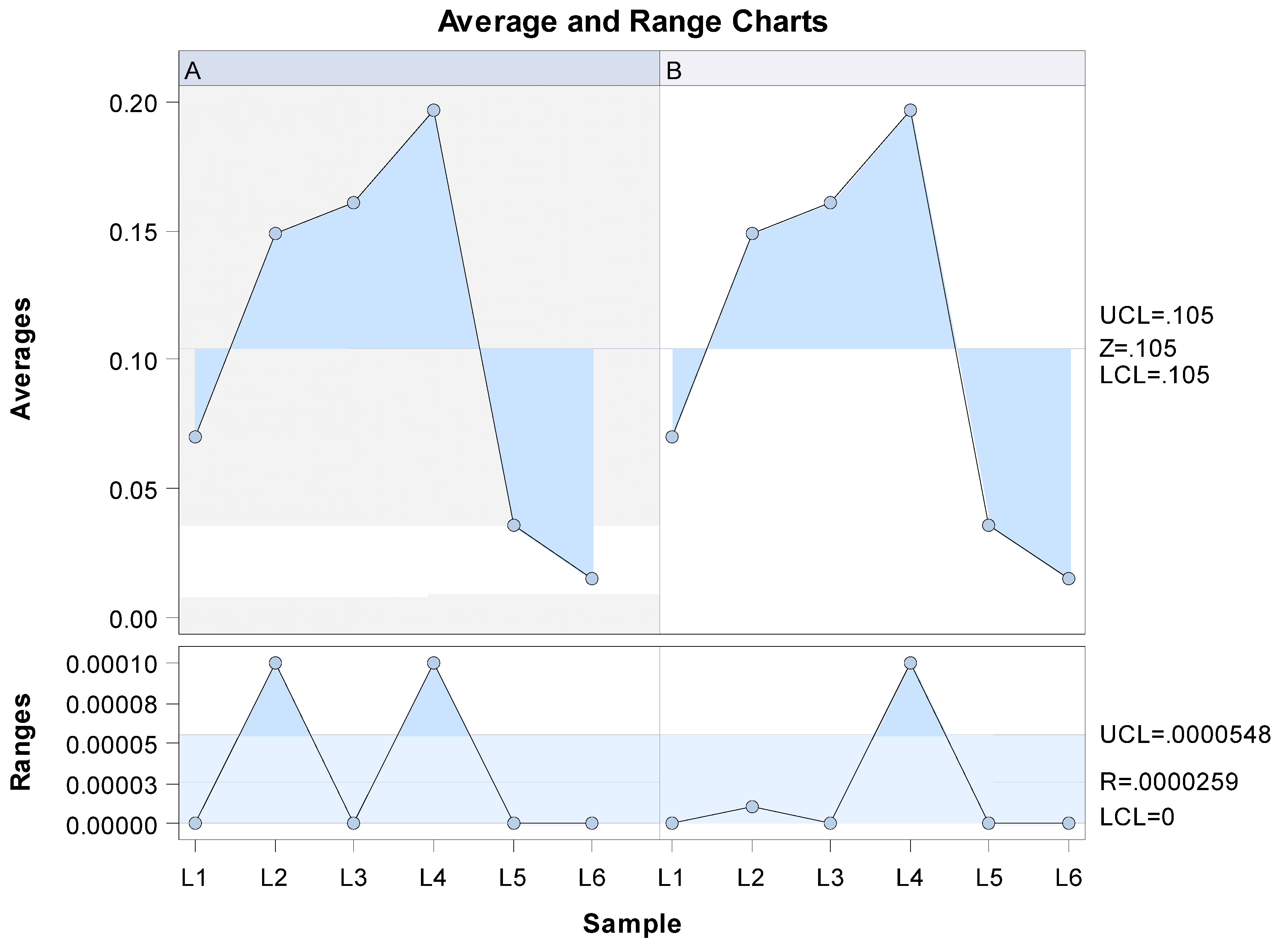A Novel Digital Technique to Analyze the Wear of CM-Wire NiTi Alloy Endodontic Reciprocating Files: An In Vitro Study
Abstract
1. Introduction
2. Materials and Methods
2.1. Study Design
2.2. Experimental Procedure
2.3. Micro-CT Scanning Procedures and Evaluation
2.4. Alignment Procedure
2.5. Measurement Procedure
2.6. Confirmation of Repeatability and Reproducibility
2.7. Statistical Tests
3. Results
4. Discussion
5. Conclusions
Author Contributions
Funding
Data Availability Statement
Conflicts of Interest
References
- Siqueira, J.F., Jr.; Rôças, I.N. Polymerase chain reaction–based analysis of microorganisms associated with failed endodontic treatment. Oral Surg. Oral Med. Oral Pathol. Oral Radiol. Endod. 2014, 97, 85–94. [Google Scholar] [CrossRef]
- Sjögren, T.; Figdor, D.; Persson, S.; Sundqvist, G. Influence of infection at the time of root filling on the outcome of endodontic treatment of teeth with apical periodontitis. Int. Endod. J. 1997, 30, 297–306. [Google Scholar] [CrossRef] [PubMed]
- Zein, N.; Harmouch, E.; Lutz, J.-C.; De Grado, G.F.; Kuchler-Bopp, S.; Clauss, F.; Offner, D.; Hua, G.; Benkirane-Jessel, N.; Fioretti, F. Polymer-Based Instructive Scaffolds for Endodontic Regeneration. Materials 2019, 12, 2347. [Google Scholar] [CrossRef]
- Cao, Y.; Morrissey, T.G.; Acome, E.; Allec, S.I.; Wong, B.M.; Keplinger, C.; Wang, C. A transparent, self-healing, highly stretchable ionic conductor. Adv. Mater. 2017, 29, 1605099. [Google Scholar] [CrossRef]
- Ahamed, S.B.B.; Vanajassun, P.P.; Rajkumar, K.; Mahalaxmi, S. Comparative Evaluation of Stress Distribution in Experimentally Designed Nickel-titanium Rotary Files with Varying Cross Sections: A Finite Element Analysis. J. Endod. 2018, 44, 654–658. [Google Scholar] [CrossRef]
- Sekar, V.; Kumar, R.; Nandini, S.; Ballal, S.; Velmurugan, N. Assessment of the role of cross section on fatigue resistance of rotary files when used in reciprocation. Eur. J. Dent. 2016, 10, 541–545. [Google Scholar] [CrossRef] [PubMed]
- Kwak, S.W.; Ha, J.-H.; Lee, C.-J.; El Abed, R.; Abu-Tahun, I.H.; Kim, H.-C. Effects of Pitch Length and Heat Treatment on the Mechanical Properties of the Glide Path Preparation Instruments. J. Endod. 2016, 42, 788–792. [Google Scholar] [CrossRef] [PubMed]
- Parashos, P.; Gordon, I.; Messer, H.H. Factors Influencing Defects of Rotary Nickel-Titanium Endodontic Instruments After Clinical Use. J. Endod. 2004, 30, 722–725. [Google Scholar] [CrossRef]
- Spili, P.; Parashos, P.; Messer, H.H. The Impact of Instrument Fracture on Outcome of Endodontic Treatment. J. Endod. 2005, 31, 845–850. [Google Scholar] [CrossRef]
- Sattapan, B.; Nervo, G.J.; Palamara, J.E.; Messer, H.H. Defects in Rotary Nickel-Titanium Files After Clinical Use. J. Endod. 2000, 26, 161–165. [Google Scholar] [CrossRef]
- Barbosa, F.O.G.; Gomes, J.A.D.C.P.; de Araújo, M.C.P. Fractographic Analysis of K3 Nickel-Titanium Rotary Instruments Submitted to Different Modes of Mechanical Loading. J. Endod. 2008, 34, 994–998. [Google Scholar] [CrossRef] [PubMed]
- Plotino, G.; Grande, N.M.; Cordaro, M.; Testarelli, L.; Gambarini, G. A Review of Cyclic Fatigue Testing of Nickel-Titanium Rotary Instruments. J. Endod. 2009, 35, 1469–1476. [Google Scholar] [CrossRef] [PubMed]
- Inan, U.; Gonulol, N. Deformation and Fracture of Mtwo Rotary Nickel-Titanium Instruments After Clinical Use. J. Endod. 2009, 35, 1396–1399. [Google Scholar] [CrossRef] [PubMed]
- McGuigan, M.B.; Louca, C.; Duncan, H.F. Clinical decision-making after endodontic instrument fracture. Br. Dent. J. 2013, 214, 395–400. [Google Scholar] [CrossRef]
- Shen, Y.; Zhou, H.-M.; Zheng, Y.; Peng, B.; Haapasalo, M. Current Challenges and Concepts of the Thermomechanical Treatment of Nickel-Titanium Instruments. J. Endod. 2013, 39, 163–172. [Google Scholar] [CrossRef]
- Yared, G. Canal preparation using only one Ni-Ti rotary instrument: Preliminary observations. Int. Endod. J. 2007, 41, 339–344. [Google Scholar] [CrossRef]
- Roane, J.B.; Sabala, C.L.; Duncanson, M.G., Jr. The “balanced force” concept for instrumentation of curved canals. J. Endod. 1985, 11, 203–211. [Google Scholar] [CrossRef]
- De-Deus, G.; Silva, E.; Vieira, V.; Belladonna, F.; Elias, C.; Plotino, G.; Grande, N.M. Blue Thermomechanical Treatment Optimizes Fatigue Resistance and Flexibility of the Reciproc Files. J. Endod. 2017, 43, 462–466. [Google Scholar] [CrossRef]
- Yamazaki-Arasaki, A.; Cabrales, R.; Dos Santos, M.; Kleine, B.M.; Prokopowitsch, I. Topography of four different endodontic rotary systems, before and after being used for the 12th time. Microsc. Res. Tech. 2012, 75, 97–102. [Google Scholar] [CrossRef]
- Arantes, W.B.; da Silva, C.M.; Lage-Marques, J.L.; Habitante, S.; da Rosa, L.C.; de Medeiros, J.M. SEM analysis of defects and wear on Ni-Ti rotary instruments. Scanning 2014, 36, 411–418. [Google Scholar] [CrossRef]
- Schneider, S.W. A comparison of canal preparations in straight and curved root canals. Oral Surg. Oral Med. Oral Pathol. Oral Radiol. Endod. 1971, 32, 271–275. [Google Scholar] [CrossRef]
- Bürklein, S.; Hinschitza, K.; Dammaschke, T.; Schäfer, E. Shaping ability and cleaning effectiveness of two single-file systems in severely curved root canals of extracted teeth: Reciproc and WaveOne versus Mtwo and ProTaper. Int. Endod. J. 2011, 45, 449–461. [Google Scholar] [CrossRef] [PubMed]
- Schneider, C.A.; Rasband, W.S.; Eliceiri, K.W. NIH Image to ImageJ: 25 Years of image analysis. Nat. Methods 2012, 9, 671–675. [Google Scholar] [CrossRef] [PubMed]
- Ruiz-Sánchez, C.; Faus-Llácer, V.; Faus-Matoses, I.; Zubizarreta-Macho, Á.; Sauro, S.; Faus-Matoses, V. The Influence of NiTi Alloy on the Cyclic Fatigue Resistance of Endodontic Files. J. Clin. Med. 2020, 9, 3755. [Google Scholar] [CrossRef] [PubMed]
- Zupanc, J.; Vahdat-Pajouh, N.; Schäfer, E. New thermomechanically treated NiTi alloys—A review. Int. Endod. J. 2018, 51, 1088–1103. [Google Scholar] [CrossRef] [PubMed]
- Ferreira, F.; Adeodato, C.; Barbosa, I.; Aboud, L.; Scelza, P.; Scelza, M.Z. Movement kinematics and cyclic fatigue of NiTi rotary instruments: A systematic review. Int. Endod. J. 2016, 50, 143–152. [Google Scholar] [CrossRef]
- Zubizarreta-Macho, Á.; Martínez, A.A.; Costa, C.F.; Quispe-López, N.; Agustín-Panadero, R.; Mena-Álvarez, J. Influence of the type of reciprocating motion on the cyclic fatigue resistance of reciprocating files in a dynamic model. BMC Oral Health 2021, 21, 179. [Google Scholar] [CrossRef]
- Zhang, E.-W.; Cheung, G.S.; Zheng, Y.-F. Influence of Cross-sectional Design and Dimension on Mechanical Behavior of Nickel-Titanium Instruments under Torsion and Bending: A Numerical Analysis. J. Endod. 2010, 36, 1394–1398. [Google Scholar] [CrossRef]
- Pedullà, E.; Plotino, G.; Grande, N.M.; Scibilia, M.; Pappalardo, A.; Malagnino, V.A.; Rapisarda, E.G. Influence of rotational speed on the cyclic fatigue of Mtwo instruments. Int. Endod. J. 2013, 47, 514–519. [Google Scholar] [CrossRef]
- Kitchens, G.G., Jr.; Liewehr, F.R.; Moon, P.C. The effect of operational speed on the fracture of nickel-titanium rotary instruments. J. Endod. 2007, 33, 52–54. [Google Scholar] [CrossRef]
- Spicciarelli, V.; Corsentino, G.; Ounsi, H.F.; Ferrari, M.; Grandini, S. Shaping effectiveness and surface topography of reciprocating files after multiple simulated uses. J. Oral Sci. 2019, 61, 45–52. [Google Scholar] [CrossRef] [PubMed]
- Zubizarreta-Macho, A.; Alonso-Ezpeleta, O.; Albaladejo Martínez, A.; Faus Matoses, V.; Caviedes Brucheli, J.; Agustín-Panadero, R.; Mena Álvarez, J.; Vizmanos Martínez-Berganza, F. Novel Electronic Device to Quantify the Cyclic Fatigue Resistance of Endodontic Reciprocating Files after Using and Sterilization. Appl. Sci. 2020, 10, 4962. [Google Scholar] [CrossRef]
- Vieira, E.P.; Nakagawa, R.K.L.; Buono, V.T.L.; Bahia, M.G.D.A. Torsional behaviour of rotary NiTi ProTaper Universal instruments after multiple clinical use. Int. Endod. J. 2009, 42, 947–953. [Google Scholar] [CrossRef]
- Aracena, D.; Borie, E.; Betancourt, P.; Aracena, A.; Guzmán, M. Wear of the Primary WaveOne single file when shaping vestibular root canals of first maxillary molar. J. Clin. Exp. Dent. 2017, 9, e368–e371. [Google Scholar] [CrossRef] [PubMed][Green Version]
- Peters, O.A.; Schönenberger, K.; Laib, A. Effects of four Ni-Ti preparation techniques on root canal geometry assessed by micro computed tomography. Int. Endod. J. 2001, 34, 221–230. [Google Scholar] [CrossRef] [PubMed]
- Connert, T.; Judenhofer, M.S.; Hülber-J, M.; Schell, S.; Mannheim, J.G.; Pichler, B.J.; Löst, C.; ElAyouti, A. Evaluation of the accuracy of nine electronic apex locators by using Micro-CT. Int. Endod. J. 2018, 51, 223–232. [Google Scholar] [CrossRef]
- Zuolo, M.L.; De-Deus, G.; Belladonna, F.G.; Silva, E.J.; Lopes, R.T.; Souza, E.M.; Versiani, M.A.; Zaia, A.A. Micro-computed Tomography Assessment of Dentinal Micro-cracks after Root Canal Preparation with TRUShape and Self-adjusting File Systems. J. Endod. 2017, 43, 619–622. [Google Scholar] [CrossRef]
- Faus-Matoses, V.; Pasarín-Linares, C.; Faus-Matoses, I.; Foschi, F.; Sauro, S.; Faus-Llácer, V.J. Comparison of Obturation Removal Efficiency from Straight Root Canals with ProTaper Gold or Reciproc Blue: A Micro-Computed Tomography Study. J. Clin. Med. 2020, 9, 1164. [Google Scholar] [CrossRef]
- Perez, R.; Neves, A.A.; Belladonna, F.G.; Silva, E.J.N.L.; Souza, E.M.; Fidel, S.; Versiani, M.A.; Lima, I.; Carvalho, C.; De-Deus, G. Impact of needle insertion depth on the removal of hard-tissue debris. Int. Endod. J. 2017, 50, 560–568. [Google Scholar] [CrossRef]






| Operator | n | Mean | SD | Minimum | Maximum | |
|---|---|---|---|---|---|---|
| A | 1 | 6 | 0.070 | 0.000 | 0.070 | 0.070 |
| 2 | 6 | 0.149 | 0.000 | 0.149 | 0.149 | |
| 3 | 6 | 0.161 | 0.000 | 0.161 | 0.161 | |
| 4 | 6 | 0.197 | 0.000 | 0.197 | 0.197 | |
| 5 | 6 | 0.036 | 0.000 | 0.036 | 0.036 | |
| 6 | 6 | 0.015 | 0.000 | 0.015 | 0.015 | |
| 7 | 6 | 0.028 | 0.000 | 0.028 | 0.028 | |
| 8 | 6 | 0.089 | 0.000 | 0.089 | 0.089 | |
| 9 | 6 | 0.104 | 0.000 | 0.104 | 0.104 | |
| 10 | 6 | 0.073 | 0.000 | 0.073 | 0.073 | |
| B | 1 | 6 | 0.070 | 0.000 | 0.070 | 0.070 |
| 2 | 6 | 0.149 | 0.000 | 0.149 | 0.149 | |
| 3 | 6 | 0.161 | 0.000 | 0.161 | 0.161 | |
| 4 | 6 | 0.197 | 0.000 | 0.197 | 0.197 | |
| 5 | 6 | 0.036 | 0.000 | 0.036 | 0.036 | |
| 6 | 6 | 0.028 | 0.000 | 0.028 | 0.028 | |
| 7 | 6 | 0.089 | 0.000 | 0.089 | 0.089 | |
| 8 | 6 | 0.104 | 0.000 | 0.104 | 0.104 | |
| 9 | 6 | 0.073 | 0.000 | 0.073 | 0.073 | |
| 10 | 6 | 0.028 | 0.000 | 0.028 | 0.028 |
Publisher’s Note: MDPI stays neutral with regard to jurisdictional claims in published maps and institutional affiliations. |
© 2022 by the authors. Licensee MDPI, Basel, Switzerland. This article is an open access article distributed under the terms and conditions of the Creative Commons Attribution (CC BY) license (https://creativecommons.org/licenses/by/4.0/).
Share and Cite
Faus-Matoses, V.; Faus-Llácer, V.; Aldeguer Muñoz, Á.; Alonso Pérez-Barquero, J.; Faus-Matoses, I.; Ruiz-Sánchez, C.; Zubizarreta-Macho, Á. A Novel Digital Technique to Analyze the Wear of CM-Wire NiTi Alloy Endodontic Reciprocating Files: An In Vitro Study. Int. J. Environ. Res. Public Health 2022, 19, 3203. https://doi.org/10.3390/ijerph19063203
Faus-Matoses V, Faus-Llácer V, Aldeguer Muñoz Á, Alonso Pérez-Barquero J, Faus-Matoses I, Ruiz-Sánchez C, Zubizarreta-Macho Á. A Novel Digital Technique to Analyze the Wear of CM-Wire NiTi Alloy Endodontic Reciprocating Files: An In Vitro Study. International Journal of Environmental Research and Public Health. 2022; 19(6):3203. https://doi.org/10.3390/ijerph19063203
Chicago/Turabian StyleFaus-Matoses, Vicente, Vicente Faus-Llácer, Álvaro Aldeguer Muñoz, Jorge Alonso Pérez-Barquero, Ignacio Faus-Matoses, Celia Ruiz-Sánchez, and Álvaro Zubizarreta-Macho. 2022. "A Novel Digital Technique to Analyze the Wear of CM-Wire NiTi Alloy Endodontic Reciprocating Files: An In Vitro Study" International Journal of Environmental Research and Public Health 19, no. 6: 3203. https://doi.org/10.3390/ijerph19063203
APA StyleFaus-Matoses, V., Faus-Llácer, V., Aldeguer Muñoz, Á., Alonso Pérez-Barquero, J., Faus-Matoses, I., Ruiz-Sánchez, C., & Zubizarreta-Macho, Á. (2022). A Novel Digital Technique to Analyze the Wear of CM-Wire NiTi Alloy Endodontic Reciprocating Files: An In Vitro Study. International Journal of Environmental Research and Public Health, 19(6), 3203. https://doi.org/10.3390/ijerph19063203







